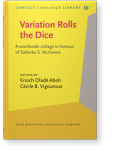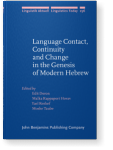Carmel O'Shannessy
List of John Benjamins publications for which Carmel O'Shannessy plays a role.
Journal
Title
Australian Contact Languages
Edited by Carmel O'Shannessy, Denise Angelo and Jane Simpson
Special issue of Journal of Pidgin and Creole Languages 39:1 (2024) vi, 311 pp.
2024 Chapter 8. The influences of adult and child speakers in the emergence of Light Warlpiri, an Australian mixed language Lifespan Acquisition and Language Change: Historical sociolinguistic perspectives, Sanz-Sánchez, Israel (ed.), pp. 179–202 | Chapter
Many analyses of language change are only able to draw on data from adult speech and therefore cannot empirically motivate a connection between an origin of a potential change and the actuation of that change throughout a community of speakers. The case study of the recent emergence of Light… read more
2024 Source language influences in the Australian mixed language, Light Warlpiri Australian Contact Languages, O'Shannessy, Carmel, Denise Angelo and Jane Simpson (eds.), pp. 125–148 | Article
A mixed language is formed through the systematic combination of subsystems from two source languages (Bakker 2017: 219). Defining features include the social history of a language and the ways in which the source language components are distributed in the mixed language, showing significant… read more
2024 Toward a typology of Australian contact languages: Towards a typology of Australian contact languages Australian Contact Languages, O'Shannessy, Carmel, Denise Angelo and Jane Simpson (eds.), pp. 1–33 | Introduction
2023 Insights from the perspective of language ecologies and new contact languages in Australia Epistemological issue: The dynamics of bilingualism in language shift ecologies, Flores, Cristina and Neal Snape (eds.), pp. 88–92 | Commentary
The situations presented in the Grenoble & Osipov paper are compared and contrasted with some of those of endangered Indigenous languages contexts in Australia. We present a typology of Australian Indigenous language ecologies, and add discussion of a specific context that does not appear in… read more
2021 Conventionalized creativity in the emergence of a mixed language – A case study of Light Warlpiri Variation Rolls the Dice: A worldwide collage in honour of Salikoko S. Mufwene, Aboh, Enoch O. and Cécile B. Vigouroux (eds.), pp. 81–104 | Chapter
Questions of how contact languages are best categorized and how their paths of development are most accurately described remain contentious. Mixed languages or split languages raise many unanswered questions about mechanisms of change in multilingual contexts, and how they lead to specific… read more
2019 Why do children lead contact-induced language change in some contexts but not others? Language Contact, Continuity and Change in the Genesis of Modern Hebrew, Doron, Edit, Malka Rappaport Hovav, Yael Reshef and Moshe Taube (eds.), pp. 321–336 | Chapter
2016 Distributions of case allomorphy by multilingual children: Speaking Warlpiri and Light Warlpiri Child Language Variation: Sociolinguistic and formal approaches, Lacoste, Véronique and Lisa Green (eds.), pp. 68–102 | Article
When a new linguistic code emerges and stabilizes, what are the roles of children and adults in leading and consolidating the changes? This question lies at the intersection of child language acquisition and contact-induced language change. Adults and children have played different roles in the… read more
2009 18. Language variation and change in a North Australian indigenous community Variation in Indigenous Minority Languages, Stanford, James N. and Dennis R. Preston (eds.), pp. 419–439 | Article
Speakers in a Warlpiri community in northern Australia are participants in a complex multilingual situation in which there has been a dramatic change in the last thirty years. Children, and adults under approximately age 30, now speak a new bilingual mixed language as the language of their everyday… read more







